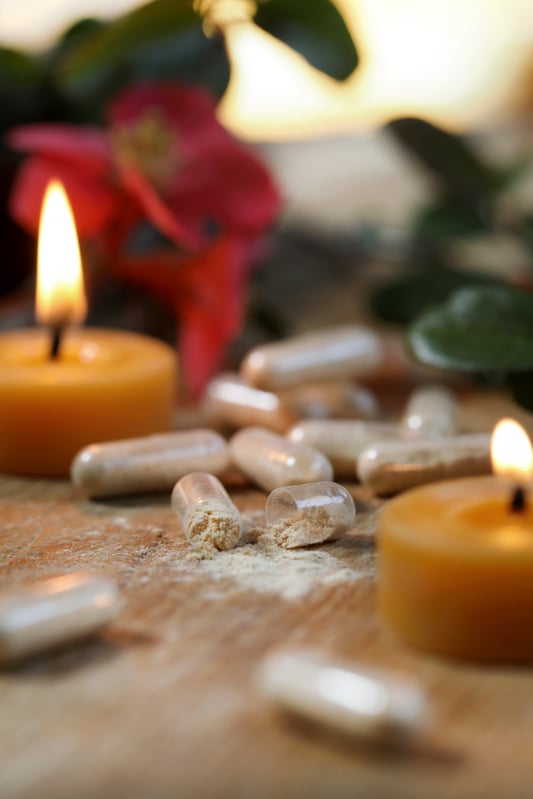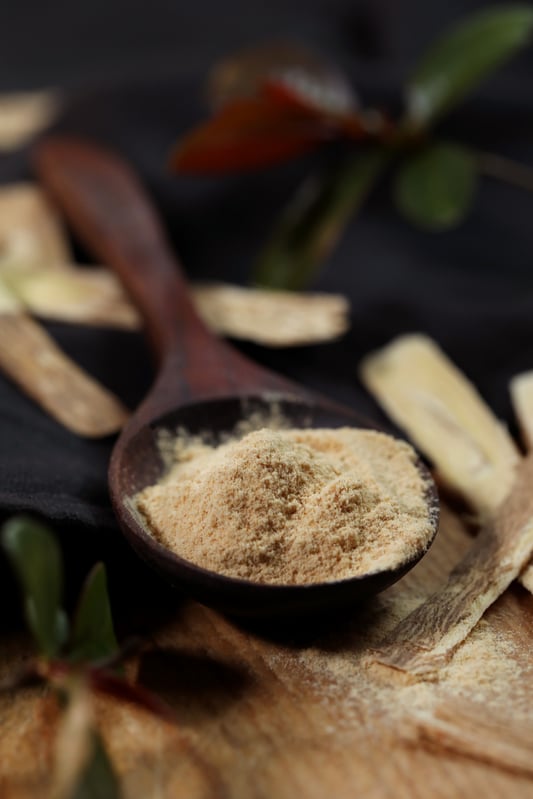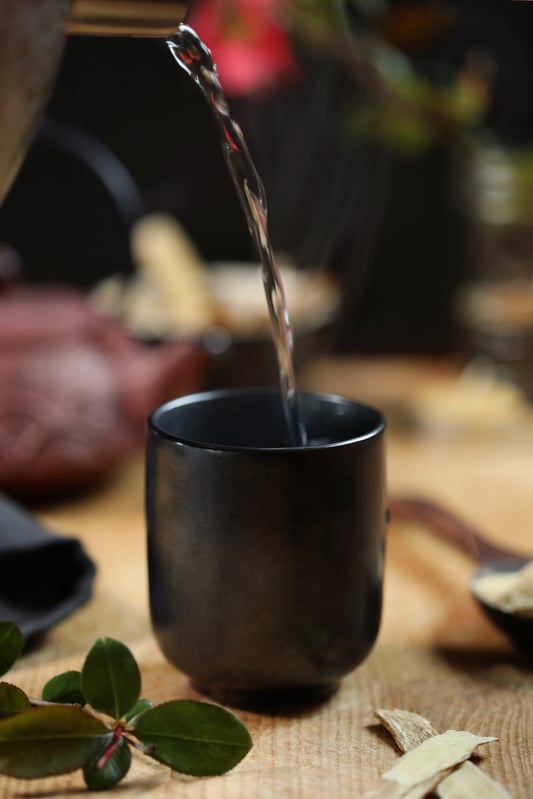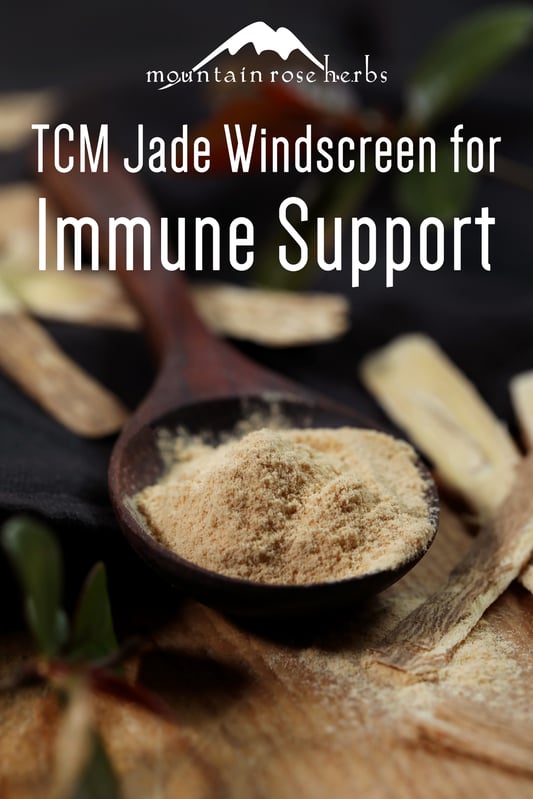
In spring, buds burst with potential energy, flowers push up from under the snow, and, according to Chinese medicine, the Wind blows change, energy, and wellness disturbances hither and thither. Spring is associated with the Wood element, in its upward, outward expansion and infinite possibilities.
The Five Elements of Chinese Medicine create a dynamic model of life and health. These elements include Water, Wood, Fire, Earth, and Metal. Each element has universal correspondences that range from microscopic movements of time and seasons, to macroscopic influences of colors, sounds, odors, and emotions.
Chinese Medicine for Spring
The “Wind” of Chinese medicine is “the origin of the one hundred diseases.” Wind can include acute disruptions to our bodies’ systems, sudden body movements, mysterious pains, or widespread wellness threats that come blowing in from other lands, whipping our lives into a frenzy of discomfort and wellness woes.
“Jade Windscreen,” or Yu Ping Feng San (玉屏風散), is a traditional Chinese herbal formula often used to reinforce our immune system, popularly used in China to prevent respiratory complaints and related conditions. The “windscreen” refers to the formula’s ability to create a screen to protect the body against wind-borne health threats.
Scientific Support for Jade Windscreen
Chinese researchers found Jade Windscreen to have “beneficial immunomodulatory effects for preventing viral infections including SARS” during the spring 2003 outbreak in Hong Kong, and “in regulating the releases of cytokines from macrophages” in another 2013 study.
Jade Windscreen Ingredients
Jade Windscreen includes just three herbs: astragalus root (Huang qi, 黃芪), atractylodes rhizome (Bai zhu, 白朮), and siler root (Fang feng, 防風). Ancient Chinese physicians designed these formulas like families, with individual plants within the formula supporting each other, creating a harmonious whole. Here’s more information about these three plants, including other herbal considerations.
- Astragalus root (Astragalus membranaceus, Apiaceae. Huang qi, 黃芪): Astragalus supports immunity * when one experiences qi deficiency, which may manifest as tiredness, weakness, or poor appetite. Its gentle flavor lends a subtle sweetness to decocted formulas and soups, while strengthening the digestive system, to support immunity. It is traditionally used in its sliced and dried form, though it can also be used as a powder or tincture. Note that astragalus can support health when one is weak, but it may “trap the thief in the house” if one is already sick, or it can tonify too much if one is already experiencing an “excess” condition. So, please use appropriately. Other immuno-modulating herbs according to Chinese medicine include reishi, codonopsis, and cordyceps.
- Atractylodes rhizome (Atractylodes macrocephala, Asteraceae. Bai zhu, 白朮): Atractylodes’ bittersweet nature augments astragalus’ functions of tonifying the digestive system to support immunity. It further helps to “dry dampness,” or move stagnant digestion. The Earth element governs digestion. Earth gives rise to Metal, which reinforces the “protective qi” (wei qi, 衛氣), which most closely correlates with the immune system. Likewise, the “three candies” of fresh ginger (sheng jiang, 生薑), Chinese date (da zao, 大棗), and licorice root (gan cao, 甘草) are often utilized together to harmonize a formula and promote digestive Earth-oriented stability.
- Siler root (Saposhnikovia divaricata, Apioceae. Fang feng, 防風): Fang feng translates as “guard against wind.” In this formula, acrid-sweet siler root supports the “protective qi,” or immune system. By expelling wind, it is said to help address headaches, body aches, and spasms in other formulas. Other considerations for “expelling wind” include mint family plants such as catnip leaf (Nepeta), or perilla leaf (zi su ye).
How to Take Jade Windscreen
Jade Windscreen is traditionally prepared as a powder blend and taken dissolved in warm water. It can also be taken as a decoction with the raw dried herb, or in granule or capsule form. Astragalus is the “King herb” of the formula, thus the high dose. If the other herbs are not available, then consider simply making an astragalus decoction, or adding it to your broth or healing stews.
Jade Windscreen Powder Blend Recipe
Ingredients
- 60 to 120 g organic astragalus root powder
- 60 g atractylodes powder
- 30 g siler root powder
Directions
I commonly advise my clients to take 9 grams of Jade Windscreen powder blend dissolved in warm water 3 times per day. For the best guidance to support your specific needs, consult a qualified TCM practitioner.
As the winds of spring and change come blowing into our lives, strengthen yourself with Jade Windscreen formula or an astragalus decoction, and keep resting fully, exercising gently, and eating whole foods meals, finding joy, peace, and stability in simple daily living. Stay grounded in the Earth amidst the movement of Wood. Breathe deep, and center.
(For more information and inspiration from the author, visit JilingLin.com.)
Looking for More Wellness Recipes?
Try This Reishi Chai for Immune Support!
You might also enjoy:
- Why We Grow Our TCM Herbs in China
- Top Herbal Remedies to Defend Your Health
- 7 Ayurvedic Herbs for Vitality, Joy & Peace of Mind
*This statement has not been evaluated by the Food and Drug Administration. This product is not intended to diagnose, treat, cure, or prevent any disease. For educational purposes only













